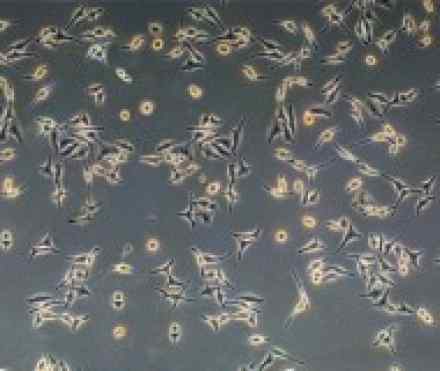
What is it?
- Cervical cancer is one of the most common cancers that affect a woman's reproductive organs. Various strains of the human papillomavirus (HPV), a sexually transmitted infection, play a role in causing most cases of cervical cancer.
- When exposed to HPV, a woman's immune system typically prevents the virus from doing harm. In a small group of women, however, the virus survives for years before it eventually converts some cells on the surface of the cervix into cancer cells. Cervical cancer occurs most often in women over age 30.
- Thanks largely to Pap test screening, the death rate from cervical cancer has decreased greatly over the last 50 years.
Symptoms
You may not experience any cervical cancer symptoms — early cervical cancer generally produces no signs or symptoms. This is why regular screening is so important. As the cancer progresses, the following signs and symptoms of more advanced cervical cancer may appear:
- Vaginal bleeding after intercourse, between periods or after menopause
- Watery, bloody vaginal discharge that may be heavy and have a foul odor
- Pelvic pain or pain during intercourse
Causes
In general, cancer begins when healthy cells acquire a genetic mutation that turns normal cells into abnormal cells. Healthy cells grow and multiply at a set rate, eventually dying at a set time. Cancer cells grow and multiply out of control, and they don't die. The accumulating abnormal cells form a mass (tumor). Cancer cells invade nearby tissues and can break off from an initial tumor to spread elsewhere in the body (metastasize).
There are two main types of cervical cancer:
- Squamous cell carcinomas begin in the thin, flat cells that line the bottom of the cervix (squamous cells). This type accounts for 80 to 90 percent of cervical cancers.
- Adenocarcinomas occur in the glandular cells that line the upper portion of the cervix. These cancers make up 10 to 20 percent of cervical cancers.
Sometimes both types of cells are involved in cervical cancer. Very rare cancers can occur in other cells in the cervix.
What causes squamous cells or glandular cells to become abnormal and develop into cancer isn't clear. However, it's certain that the sexually transmitted infection called human papillomavirus (HPV) plays a role. Evidence of HPV is found in nearly all cervical cancers. However, HPV is a very common virus and most women with HPV never develop cervical cancer. This means other risk factors, such as your genetic makeup, your environment or your lifestyle choices, also determine whether you'll develop cervical cancer.
Risk factors
These factors may increase your risk of cervical cancer:
- Many sexual partners. The greater your number of sexual partners — and the greater your partner's number of sexual partners — the greater your chance of acquiring HPV.
- Early sexual activity. Having sex before age 18 increases your risk of HPV. Immature cells seem to be more susceptible to the precancerous changes that HPV can cause.
- Other sexually transmitted diseases (STDs). If you have other STDs — such as chlamydia, gonorrhea, syphilis or HIV/AIDS — the greater your chance is of also having HPV.
- A weak immune system. Most women who are infected with HPV never develop cervical cancer. However, if you have an HPV infection and your immune system is weakened by another health condition, you may be more likely to develop cervical cancer.
- Cigarette smoking. The exact mechanism that links cigarette smoking to cervical cancer isn't known, but tobacco use increases the risk of precancerous changes as well as cancer of the cervix. Smoking and HPV infection may work together to cause cervical cancer.
Complications
- Treatments for invasive cervical cancer often make it impossible to become pregnant in the future. For many women — especially younger women and those who have yet to begin a family — infertility is a distressing side effect of treatment. If you're concerned about your ability to get pregnant in the future, discuss this with your doctor.
- For a specific subgroup of women with early cervical cancer, fertility-sparing surgery may be a treatment option. A surgical procedure to remove only your cervix and surrounding lymphatic tissue (radical trachelectomy) may preserve your uterus.
- Studies of radical trachelectomy suggest that cervical cancer can be cured using this technique, though it isn't appropriate for every woman and there may be added risks to this surgery. Future pregnancies are possible, but must be managed carefully because removing the cervical tissue can lead to a higher incidence of miscarriage and premature birth.
- Tell your doctor about your concerns about infertility before your treatment begins. In most cases, preserving fertility is more successful than trying to restore fertility after treatment.
Diagnosis
Screening
Each year more than 10,000 women in the United States are diagnosed with invasive cervical cancer, and nearly 4,000 die of the disease. Most of these deaths could be prevented if all women received recommended screening.
Most guidelines suggest beginning screening at age 21, and some recommend starting within three years of becoming sexually active, or no later than age 21. Screening may include:
Pap test. During a Pap test, your doctor brushes cells from your cervix — the narrow neck of the uterus — and sends the sample to a lab to be examined for abnormalities.
A Pap test can detect abnormal cells in the cervix. This is the precancerous stage, when the abnormal cells (dysplasia) exist only in the outer layer of the cervix and haven't invaded deeper tissues. If untreated, the abnormal cells may convert to cancer cells, which may spread in various stages into the cervix, the upper vagina and the pelvic areas and to other parts of your body. Cancer or precancerous conditions that are caught at the pre-invasive stage are rarely life-threatening and typically require only outpatient treatment.
HPV DNA test. Your doctor also may use a lab test called the HPV DNA test to determine whether you are infected with any of the 13 types of HPV that are most likely to lead to cervical cancer. Like the Pap test, the HPV DNA test involves collecting cells from the cervix for lab testing. It can detect high-risk strains of HPV in cell DNA before changes to the cells of the cervix can be seen.
The HPV DNA test isn't a substitute for regular Pap screening, and it's not used to screen women younger than 30 with normal Pap results. Most HPV infections in women of this age group clear up on their own and aren't associated with cervical cancer.
Diagnosis
If you experience signs and symptoms of cervical cancer or if a Pap test has revealed cancerous cells, you may undergo further tests to diagnose your cancer. To make a diagnosis, your doctor may:
- Examine your cervix. During an exam called colposcopy, your doctor uses a special microscope (colposcope) to examine your cervix for abnormal cells. If unusual areas are identified, your doctor may take a small sample of cells for analysis (biopsy).
- Take a sample of cervical cells. During a biopsy procedure your doctor removes a sample of unusual cells from your cervix using special tools. During one type of biopsy — punch biopsy — your doctor uses a circular knife to remove a small circular section of the cervix. Other special types of biopsy may be used depending on the location and size of the unusual area of cells.
- Remove a cone-shaped area of cervical cells. A cone biopsy (conization) — so called because it involves taking a cone-shaped sample of the cervix — allows your doctor to obtain deeper layers of cervical cells for laboratory testing. Your doctor may use a scalpel, laser or electrified wire loop to remove the tissue.
Staging
If your doctor determines that you have cervical cancer, you'll undergo further tests to determine whether your cancer has spread and to what extent — a process called staging. Your cancer's stage is a key factor in deciding on your treatment. Staging exams include:
- Imaging tests. Tests such as X-rays, computerized tomography (CT) scans and magnetic resonance imaging (MRI) help your doctor determine whether your cancer has spread beyond your cervix.
- Visual examination of your bladder and rectum. Your doctor may use special scopes to see inside your bladder (cystoscopy) and rectum (proctoscopy).
- Your doctor then assigns your cancer a stage — typically a Roman numeral.
Stages of cervical cancer include:
- Stage 0. Also called carcinoma in situ or noninvasive cancer, this early cancer is small and confined to the surface of the cervix.
- Stage I. Cancer is confined to the cervix.
- Stage II. Cancer at this stage includes the cervix and uterus, but hasn't spread to the pelvic wall or the lower portion of the vagina.
- Stage III. Cancer at this stage has moved beyond the cervix and uterus to the pelvic wall or the lower portion of the vagina.
- Stage IV. At this stage, cancer has spread to nearby organs, such as the bladder or rectum, or it has spread to other areas of the body, such as the lungs, liver or bones.
Treatments and drugs
Limited, noninvasive cancer
Treatment of cervical cancer that's confined to the outside layer of the cervix typically requires treatment to remove the abnormal area of cells. For most women in this situation, no additional treatments are needed. Procedures to remove noninvasive cancer include:
- Cone biopsy (conization). During this surgery, the doctor uses a scalpel to remove a cone-shaped piece of cervical tissue where the abnormality is found.
- Laser surgery. This operation uses a narrow beam of intense light to kill cancerous and precancerous cells.
- Loop electrosurgical excision procedure (LEEP). This technique uses a wire loop to pass electrical current, which cuts like a surgeon's knife, and remove cells from the mouth of the cervix.
- Cryosurgery. This technique involves freezing and killing cancerous and precancerous cells.
- Hysterectomy. This major surgery involves removal of the cancerous and precancerous areas, the cervix and the uterus. Hysterectomy is usually done only in certain selected cases of noninvasive cervical cancer.
Invasive cancers
Cervical cancer that invades deeper than the outside layer of cells on the cervix is referred to as invasive cancer and requires more extensive treatment. Treatment for cervical cancer depends on several factors, such as the stage of the cancer, other health problems you may have and your own preferences about treatment. Treatment options may include:
Surgery. Surgery to remove the uterus (hysterectomy) is typically used to treat the early stages of cervical cancer. A simple hysterectomy involves the removal of the cancer, the cervix and the uterus. Simple hysterectomy is typically an option only when the cancer is very early stage — invasion is less than 3 millimeters (mm) into the cervix. A radical hysterectomy — removal of the cervix, uterus, part of the vagina and lymph nodes in the area — is the standard surgical treatment when there's an invasion of greater than 3 mm into the cervix and no evidence of tumor on the walls of the pelvis.
Hysterectomy can cure early-stage cervical cancers and prevent cancer from coming back, but removing the uterus makes it impossible to become pregnant. Expect about six weeks of recovery time. Temporary side effects of radical hysterectomy include pelvic pain and difficulty with bowel movements and urination.
Radiation. Radiation therapy uses high-powered energy to kill cancer cells. Radiation therapy can be given externally using external beam radiation or internally (brachytherapy) by placing devices filled with radioactive material near your cervix. Radiation therapy is as effective as surgery for early-stage cervical cancer. For women with more advanced cervical cancer, radiation combined with cisplatin-based chemotherapy is considered the most effective treatment.
Side effects of radiation to the pelvic area include upset stomach, nausea, diarrhea, bladder irritation and narrowing of your vagina, which can make intercourse difficult. Premenopausal women may stop menstruating as a result of radiation therapy and begin menopause.
Chemotherapy. Chemotherapy uses strong anti-cancer medications to kill cancer cells. Chemotherapy drugs, which can be used alone or in combination with each other, are usually injected into a vein and they travel throughout your body killing quickly growing cells, including cancer cells. The chemotherapy drug called cisplatin is often combined with radiation therapy to enhance overall treatment effectiveness. Side effects of chemotherapy depend on the drugs, but generally include diarrhea, fatigue, nausea and hair loss. Certain chemotherapy drugs may cause infertility and early menopause in premenopausal women.
Coping and support
No one can be prepared for a cancer diagnosis. You can, however, try to manage the shock and fear you're feeling by taking steps to control what you can about your situation. Every woman deals with a cervical cancer diagnosis in her own way. With time you'll discover what helps you cope with your feelings. Until then, you can start to take control of your emotions by attempting to:
- Learn everything you can about cervical cancer. Write down your questions and ask them at the next appointment with your doctor. Get a friend or family member to come to appointments with you to take notes. Ask your health care team for further sources of information. The more you know about your condition, the better prepared you'll be to make decisions about your treatment.
- Create a support network. Don't face your diagnosis alone. Friends and family are likely feeling helpless and afraid, too. They want to help, so take them up on their offers. Ask loved ones to take over daily tasks such as cooking, household chores or child care. Talk with close friends and family when you're feeling overwhelmed. Other people with cancer can offer unique emotional support during your diagnosis and treatment. Connect with cancer survivors through support groups — in your community and on the Web.
- Take time for yourself. Take care of yourself during cancer treatment. It's OK to tell friends and family that you need some time for yourself. Writing in a journal, listening to music or painting can all be beneficial ways to reduce stress and cope with your emotions.
Prevention
You can reduce your risk of cervical cancer by taking measures to prevent HPV infection. HPV spreads through skin-to-skin contact with any infected part of the body — not just during intercourse. Use a condom every time you have sex in order to reduce your risk of contracting HPV.
In addition to using condoms, the best ways to prevent cervical cancer are to:
- Delay first intercourse
- Have fewer sexual partners
- Avoid smoking
Get vaccinated against HPV
A vaccine called Gardasil offers protection from the most dangerous types of HPV — the virus that causes most cervical cancers. The national Advisory Committee on Immunization Practices recommends routine vaccination for girls ages 11 and 12, as well as girls and women ages 13 to 26 if they haven't received the vaccine already. The vaccine is most effective if given to girls before they become sexually active.
Although the vaccine could prevent up to 70 percent of cervical cancer cases, it can't prevent infection with every virus that causes cervical cancer. Routine Pap tests to screen for cervical cancer remain important.
Have routine Pap tests
Routine Pap tests are the most effective way to detect cervical cancer in the earliest stages. Work with your doctor to determine the best schedule for Pap tests. Current guidelines suggest:
- An initial Pap test at age 21, or within three years of when you begin having sex, whichever comes first.
- From ages 21 to 29, a regular Pap test every two to three years.
- From ages 30 to 69, a regular Pap test every two or three years if you've had three normal Pap tests in a row.
- From ages 65 to 70 on, you may stop having Pap tests if you've had three or more normal tests in a row and no abnormal results in the last 10 years.
If you're at high risk of cervical cancer, you'll need more frequent Pap tests. If you've had a hysterectomy, talk with your doctor about whether to continue getting Pap tests. If the hysterectomy was done for a noncancerous condition, such as fibroids, you may discontinue routine Pap tests, but not pelvic exams. If the hysterectomy was done for a precancerous or cancerous condition, your vaginal canal still needs to be checked for abnormal changes.
References:
http://www.cancer.org/cancer/cervicalcancer/moreinformation/cervicalcancerpreventionandearlydetection/cervical-cancer-prevention-and-early-detection-cervical-cancer-signs-and-symptoms
http://www.cancer.ie/cancer-information/cervical-cancer/symptoms-and-diagnosis#sthash.B93qm65b.dpbs
http://www.cervicalcheck.ie/about-cervical-screening/cervical-cancer.5638.html
http://www.medicinenet.com/cervical_cancer/article.htm
https://en.wikipedia.org/wiki/Cervical_cancer




